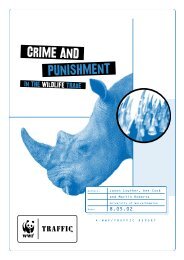In full swing: assessment of trade in orang-utans and ... - WWF UK
In full swing: assessment of trade in orang-utans and ... - WWF UK
In full swing: assessment of trade in orang-utans and ... - WWF UK
You also want an ePaper? Increase the reach of your titles
YUMPU automatically turns print PDFs into web optimized ePapers that Google loves.
This report deals exclusively with the <strong>trade</strong> <strong>in</strong> gibbons <strong>and</strong> <strong>orang</strong>-<strong>utans</strong> on the isl<strong>and</strong>s <strong>of</strong> Java <strong>and</strong> Bali. All but one <strong>of</strong><br />
the species <strong>in</strong>cluded <strong>in</strong> this <strong>assessment</strong> do not occur naturally on Java <strong>and</strong> Bali. The lone exception is the Javan Gibbon,<br />
a species conf<strong>in</strong>ed to the forests <strong>of</strong> western Java. The <strong>assessment</strong> deals with all species <strong>of</strong> gibbon <strong>and</strong> both species <strong>of</strong><br />
<strong>orang</strong>-utan, irrespective <strong>of</strong> where they occur naturally, but is restricted to those <strong>in</strong>dividuals that are <strong>trade</strong>d on, kept on,<br />
or transported over Java <strong>and</strong>/or Bali. <strong>In</strong> terms <strong>of</strong> <strong>In</strong>donesia’s wildlife <strong>trade</strong> dynamics, Java, <strong>and</strong> to a lesser extent Bali,<br />
can be seen as the ‘import’ or consumer regions, whereas Sumatra <strong>and</strong> Kalimantan (the <strong>In</strong>donesian part <strong>of</strong> the isl<strong>and</strong> <strong>of</strong><br />
Borneo) are the ‘export’ or producer regions. Obta<strong>in</strong><strong>in</strong>g a complete picture <strong>of</strong> <strong>trade</strong> <strong>in</strong> gibbons <strong>and</strong> <strong>orang</strong>-<strong>utans</strong> requires<br />
data from both import <strong>and</strong> export regions. However, s<strong>in</strong>ce the dynamics <strong>of</strong> <strong>trade</strong> differ considerably between the two,<br />
as do the amount <strong>and</strong> quality <strong>of</strong> data that can be collected, this report focuses exclusively on Java <strong>and</strong> Bali.<br />
The species <strong>of</strong> <strong>in</strong>terest<br />
Of the 13 species <strong>of</strong> gibbon that are distributed <strong>in</strong> Southeast<br />
Asia, seven are present with<strong>in</strong> <strong>In</strong>donesia, as are both species<br />
<strong>of</strong> <strong>orang</strong>-utan (Table 1). Both <strong>in</strong> terms <strong>of</strong> number <strong>of</strong> species<br />
<strong>and</strong> size <strong>of</strong> their populations worldwide, <strong>In</strong>donesia ranks<br />
first, <strong>and</strong> as such, the country has a large responsibility for<br />
the conservation <strong>of</strong> gibbons <strong>and</strong> <strong>orang</strong>-<strong>utans</strong>.<br />
With respect to gibbons, no records <strong>of</strong> any species other<br />
than those that occur naturally <strong>in</strong> <strong>In</strong>donesia were<br />
encountered <strong>in</strong> the process <strong>of</strong> data compilation, <strong>and</strong> <strong>in</strong>deed,<br />
none <strong>of</strong> them are present <strong>in</strong> <strong>In</strong>donesian zoos. For brevity,<br />
this report, therefore, only provides <strong>in</strong>formation on the<br />
seven species <strong>of</strong> gibbon that occur <strong>in</strong> <strong>In</strong>donesia <strong>and</strong> that are<br />
more or less regularly encountered <strong>in</strong> bird markets 1 or <strong>in</strong><br />
Bird market, <strong>In</strong>donesia<br />
zoos. Taxonomy <strong>and</strong> nomenclature <strong>of</strong> primates follows<br />
Groves (2001); when referr<strong>in</strong>g to gibbons, this <strong>in</strong>cludes the<br />
Siamang, unless the particular analysis mentions the Siamang separately <strong>in</strong> the same sentence, <strong>in</strong> which case the Siamang<br />
is excluded.<br />
Credit: Chris R. Shepherd/TRAFFIC Southeast Asia<br />
The gibbons are collectively known as the lesser or smaller ape. They split from the other apes between 12-20 million<br />
years ago. It is the most species-rich group <strong>of</strong> apes with some 13 extant species currently recognized. All live <strong>in</strong><br />
Southeast Asia, <strong>and</strong> many have restricted ranges on (parts <strong>of</strong>) isl<strong>and</strong>s. The northernmost part <strong>of</strong> their present<br />
distribution is <strong>in</strong> southern Ch<strong>in</strong>a <strong>and</strong> Ha<strong>in</strong>an, but even <strong>in</strong> historic times, their distribution range extended as far north as<br />
the Yellow River (Geissmann, 1995).<br />
The follow<strong>in</strong>g seven species occur <strong>in</strong> <strong>In</strong>donesia:<br />
Javan Gibbon Hylobates moloch: Endemic to the western part <strong>of</strong> Java, it occurs <strong>in</strong> the last fragments <strong>of</strong> lowl<strong>and</strong> <strong>and</strong><br />
hill forest. MacK<strong>in</strong>non (1987) estimated that some 98% <strong>of</strong> the habitat <strong>of</strong> the Javan Gibbon has been destroyed, much<br />
<strong>of</strong> it <strong>in</strong> the second half <strong>of</strong> the 19 th <strong>and</strong> the first half <strong>of</strong> the 20 th century. Populations are severely scattered <strong>and</strong> there are<br />
1 <strong>In</strong> most <strong>of</strong> the larger cities on Java <strong>and</strong> Bali, but also <strong>in</strong> any <strong>of</strong> the smaller ones, a large range <strong>of</strong> animals are <strong>trade</strong>d at what is commonly known as bird markets (pasar<br />
burung) or wildlife markets (pasar satwa). At some <strong>of</strong> these bird markets, the vast majority <strong>of</strong> animals <strong>trade</strong>d are <strong>in</strong>deed birds, but some <strong>of</strong> them also have relatively large<br />
quantities <strong>of</strong> other animal groups on <strong>of</strong>fer. Although the term “bird market” does not perhaps adequately describe the fact that not just birds are <strong>trade</strong>d, as it is widely used<br />
<strong>in</strong> <strong>In</strong>donesian, <strong>in</strong> this report the term is reta<strong>in</strong>ed.<br />
IN FULL SWING:ASSESSMENT OF TRADE IN ORANGUTANS AND GIBBONS ON JAVA AND BALI,INDONESIA 4



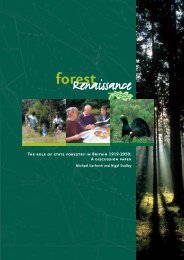
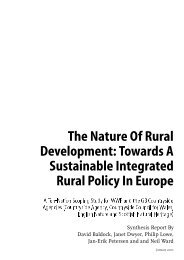
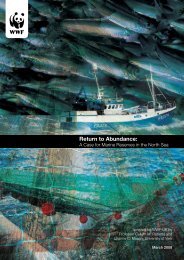

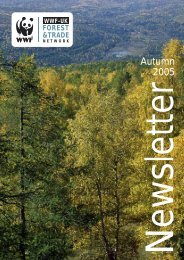

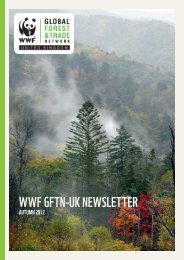
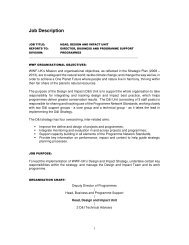
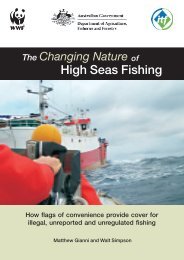
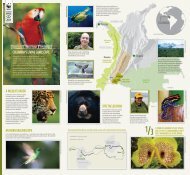
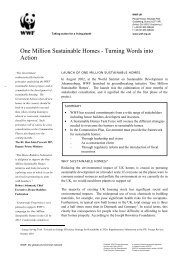
![[PDF] Causes for concern: chemicals and wildlife - WWF UK](https://img.yumpu.com/31929970/1/184x260/pdf-causes-for-concern-chemicals-and-wildlife-wwf-uk.jpg?quality=85)
